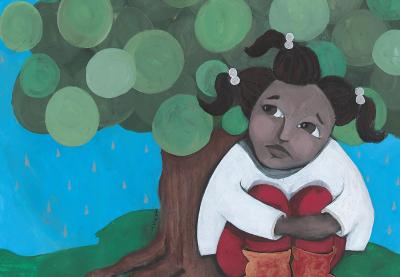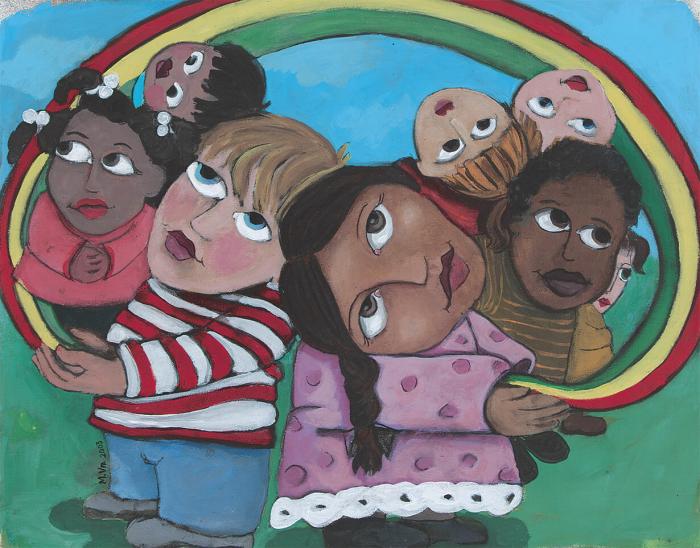Where could she be?
"She was sad and ran away," the children reported, "and now we can't find her!"
I was aware of the recess bell ringing loudly, the crunching of many small feet on the snow. The sounds faded away slowly as I herded the classes inside, until there was only silence.
A flicker of red behind a tree caught my eye — her small rubber boot. I found her sitting there, hugging her knees and whimpering.
Her body was fine — she had been missing for less than 15 minutes — but her spirit was shattered. We talked quietly about what had happened and, in a few minutes, she uncurled and we walked inside.
As the guidance counselor at an elementary school in a small New Hampshire town, I thought I had been dealing effectively with this bullying situation, in which several children had set their sights on this one girl.
Traditional interventions (small group, individual counseling, classroom guidance, parent conferences) were obviously having little or no effect. The bullies had stuck with their project relentlessly, using snide looks, vicious whispering and a systematic plan to totally isolate one child on the playground.
The victim had suffered obediently in silence, believing what the bullies said about her — that she was unattractive, slow to learn, had a weird laugh and that no one wanted to play with her or be her friend. How did she come to accept the negative self-images? Why did she abandon her own right to be free from fear on the playground?
These children had no language or context to understand why their hurtful behaviors were so painful and damaging.
That became my goal: I would create this absent language for children in schools. I called it "Hurt-Free Schools."
Little did I realize that educators on a distant continent were involved in a similar, even more desperate, search for this new language. Far away in a land of both great beauty and great pain, other schools were struggling to stop the damages caused by bullies.
My pledge to create a language of empowerment for children led me to South Africa, a country struggling to recover from a giant among all-time bullies, apartheid. Interestingly, my journey to South Africa began in Glasgow, Scotland, at a university conference where I presented my anti-bullying program. There, I engaged in a lively discussion with a South African educator that ended with my half-humorous, utterly sincere offer to come to South Africa to teach the Hurt-Free model. I've spent the past three summers doing just that.
It didn't matter whether the school was located in Nashua or Kwa-Zulu Natal, we were both looking for the same thing: a way to teach and empower all children to claim their universal right to live in emotional, social and physical safety within a climate of peace and mutual respect.
As my work evolved, I developed the basic foundation for my vision: the positive presence of a school community that promises to work together to weave a web of emotional, social and physical safety around every child.
Of all the elements of a Hurt-Free School, I believe the most vital concept is that it is child-friendly.
I constantly remind myself of the child curled in the snow, now grown. What strategies could have made a difference for her in that bullying situation? What tools could she have used to understand her rights and to get the help she needed?
I believe that every intervention designed to build a climate of safety in school must be easily understood, developmentally appropriate and, most important, give children real tools they can use on the playground.
I chose the rainbow to embody my child-friendly vision. The "Rainbow of Safety," as I call it, meets all of my criteria: universal and protective, honoring individuality and celebrating diversity.
The words of children say it all:
It’s a rainbow that goes over the whole school. Everyone is under it; no one is left out.
Even when there’s a really scary storm with thunder and lightning, it makes you feel good to know that you might get to see a rainbow when the rain stops.
I don’t have to be afraid to tell a bully to stop on my own because I know that other kids will come over to help me.
I know how and when to ask for help from an adult if I don’t feel safe.
The Color of Safety
The Rainbow of Safety uses four colors to help children process decisions about their behaviors in school.
It is important to set firm guidelines regarding the use of these colors.
Children need to be reminded that the colors stand for the decisions they make about what they say or do. Young children should be reassured that choices can be changed, turning mistakes and missed opportunities into better decisions in the future.
True Blue
True Blue is the first color of our rainbow. This universal color of the sky represents the best of humankind: equity, respect, acceptance, kindness, responsibility and tolerance. True Blue is what we reach for under the Rainbow of Safety.
Again, my trip to South Africa reminded me of the universal message behind True Blue. Just as life, liberty and the pursuit of happiness have meaning to Americans, the word ubuntu has meaning to South Africans.
The Zulu word ubuntu describes our relationships to one another. Though difficult to define, ubuntu is, to me, the connection to one another that makes us uniquely human. To experience our humanity most fully, we must honor these bonds to one another, intertwining our journeys through life with mutual concern and respect.
The first time I used ubuntu to describe True Blue was in front of about 100 girls sitting cross-legged on the floor. The girls looked at each other, eye to eye, recognizing their mother tongue. It passed between them like a shock of electricity, leaving proud smiles and straightened shoulders.
I have adapted this word as one of the elements of the Rainbow of Safety in South Africa. Ubuntu in school means that we must work together if we want a safe school. If even one child is afraid to be hurt on the playground, our school is not a safe place. When we are all watching for one another’s safety, we know that:
- If you are hurt on the playground, someone will come over to see if you are all right.
- If you are alone, you are welcome to join in a game.
- If you are being teased by a bully, other children will come and tell the bully to stop.
- If you need help, ask an adult.
In real life, we know, adults struggle to reach True Blue behavior. How then can a child be expected to meet such lofty ideals?
The Rainbow of Safety uses the image of the traffic light (or robot in South Africa) to help children strive to be as Blue as possible. By using a universal image, like a real traffic light with cars approaching an intersection, children may look to the Rainbow’s traffic light to guide them safely through their behavior decisions in school.
Growing Green
Growing Green is a comfortable, friendly color for most American children. It encourages them to act upon their best intentions, yet supports them if they fall short of their goals. Children are works in progress who must be given encouragement and as many successful experiences as possible.
Caution Yellow
Caution Yellow teaches children that thoughtless choices can take away others' rights and have significant impact on a school's level of safety. Children are urged to stop, think and make choices that turn Yellow behavior back to Green with words like:
I’m sorry.
I should not have said that.
I didn’t mean to hurt you.
I’ll try harder to pay more attention to your rights/feelings next time.
Yellow provides a concrete tool to help even the very young child grasp the subtle concepts behind social climate theory.
The Rainbow of Safety addresses the "spectator syndrome," which bullying depends upon for its ongoing survival. Choosing to look away, doing nothing or not seeking adult help when needed are unacceptable options in a Hurt-Free School. Children are taught that such choices jeopardize the safety of all and can turn Caution Yellow into Danger Red if better choices aren’t made.
Danger Red
Danger Red hurts! It is never acceptable under the Rainbow of Safety. It differs from Yellow in that it represents a deliberate choice to hurt another person. Red behavior becomes bullying when it is hurtful, deliberate, repeated and continues even after the bully has been told to stop.
Our school now overflows with Rainbow of Safety language. Traffic lights are found in hallways and classrooms. Mini-traffic lights are on every student’s desk, used in some cases as part of individual behavior contracts with teachers. Students use giant rainbow sunglasses, visors and teddy bears to role-play real-life behavior challenges.
If students are not listening attentively, the teacher stops and says quietly, "I will wait until your listening turns back to Green."
The morning announcements talk about True Blue with a behavior challenge such as: "Telling the truth is not as hard as it may seem. If you start to say something Yellow, stop and change it to Green."
The Rainbow of Safety offers a plan — indeed, a set of tools — to give schools the strategies they need to make every school day count for every child.
Rather than accept the hopelessness that keeps bullying alive, the Rainbow of Safety offers a neutral language that teaches all children to claim their rights to safety while respecting those of others.
So not only can you find that little girl curled up in the snow, but you can offer her tools to rejoin life, with safety and comfort, on the playground and in the classroom.



0 COMMENTS